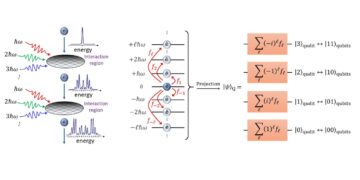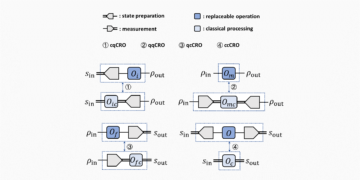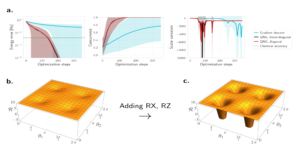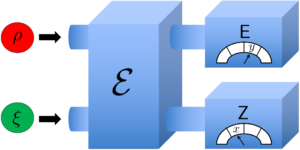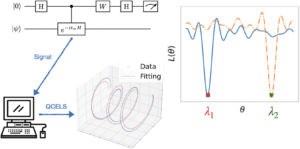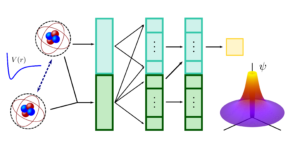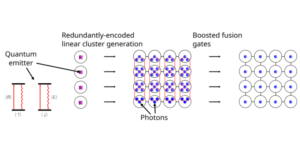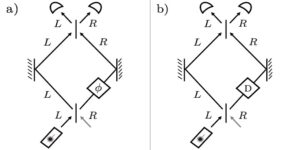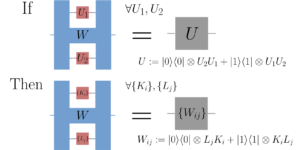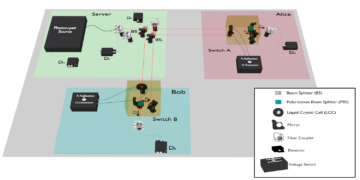Institute of Physics and Applied Computer Science, Faculty of Applied Physics and Mathematics, Gdańsk University of Technology, Narutowicza 11/12, 80-233 Gdańsk, Poland
Find this paper interesting or want to discuss? Scite or leave a comment on SciRate.
Abstract
We put forward a simple construction of genuinely entangled subspaces – subspaces supporting only genuinely multipartite entangled states – of any permissible dimensionality for any number of parties and local dimensions. The method uses nonorthogonal product bases, which are built from totally nonsingular matrices with a certain structure. We give an explicit basis for the constructed subspaces. An immediate consequence of our result is the possibility of constructing in the general multiparty scenario genuinely multiparty entangled mixed states with ranks up to the maximal dimension of a genuinely entangled subspace.
► BibTeX data
► References
[1] M. Seevinck and J. Uffink, Sufficient conditions for three-particle entanglement and their tests in recent experiments, Phys. Rev. A 65, 012107 (2001).
https://doi.org/10.1103/PhysRevA.65.012107
[2] Y. Yeo and W. K. Chua, Teleportation and Dense Coding with Genuine Multipartite Entanglement, Phys. Rev. Lett. 96, 060502 (2006).
https://doi.org/10.1103/PhysRevLett.96.060502
[3] G. Tóth, Multipartite entanglement and high-precision metrology, Phys. Rev. A 85, 022322 (2012).
https://doi.org/10.1103/PhysRevA.85.022322
[4] M. Epping, H. Kampermann, Ch. Macchiavello, and Dagmar Bruß, Multi-partite entanglement can speed up quantum key distribution in networks, New J. Phys. 19, 093012 (2017).
https://doi.org/10.1088/1367-2630/aa8487
[5] F. Grasselli, G. Murta, H. Kampermann, and D. Bruß, Entropy Bounds for Multiparty Device-Independent Cryptography, PRX Quantum 2, 010308 (2021).
https://doi.org/10.1103/PRXQuantum.2.010308
[6] T. Cubitt, A. Montanaro, and A. Winter, On the dimension of subspaces with bounded Schmidt rank, J. Math. Phys. 49, 022107 (2008).
https://doi.org/10.1063/1.2862998
[7] M. Demianowicz and R. Augusiak, From unextendible product bases to genuinely entangled, Phys. Rev. A 98, 012312 (2018).
https://doi.org/10.1103/PhysRevA.98.012313
[8] K. Parthasarathy, On the maximal dimension of a completely entangled subspace for finite level quantum systems, Proceedings Mathematical Sciences 114, 365 (2004).
https://doi.org/10.1007/BF02829441
[9] S. Agrawal, S. Halder, M. Banik, Genuinely entangled subspace with all-encompassing distillable entanglement across every bipartition, Phys. Rev. A 99, 032335 (2019).
https://doi.org/10.1103/PhysRevA.99.032335
[10] K. Wang, L. Chen, L. Zhao, Y. Guo, 4 $times$ 4 unextendible product basis and genuinely entangled space, Quantum Inf. Process. 18, 202 (2019).
https://doi.org/10.1007/s11128-019-2324-4
[11] A. H. Shenoy and R. Srikanth, Maximally nonlocal subspaces, J. Phys. A: Math. Theor. 52, 095302 (2019).
https://doi.org/10.1088/1751-8121/ab0046
[12] F. Huber and M. Grassl, Quantum Codes of Maximal Distance and Highly Entangled Subspaces, Quantum 4, 284 (2020).
https://doi.org/10.22331/q-2020-06-18-284
[13] F. Baccari, R. Augusiak, I. Šupić, and A. Acín, Device-Independent Certification of Genuinely Entangled Subspaces, Phys. Rev. Lett. 125, 260507 (2020).
https://doi.org/10.1103/PhysRevLett.125.260507
[14] M. Demianowicz, G. Rajchel–Mieldzioć, and R. Augusiak, Simple sufficient condition for subspace to be completely or genuinely entangled, New J. Phys. 23, 103016 (2021).
https://doi.org/10.1088/1367-2630/ac2a5c
[15] C. H. Bennett, D. P. DiVincenzo, T. Mor, P. W. Shor, J. A. Smolin, and B. M. Terhal, Unextendible Product Bases and Bound Entanglement, Phys. Rev. Lett. 82, 5385 (1999).
https://doi.org/10.1103/PhysRevLett.82.5385
[16] D. P. DiVincenzo, T. Mor, P. W. Shor, J. A. Smolin, B. M. Terhal, Unextendible Product Bases, Uncompletable Product Bases and Bound Entanglement, Comm. Math. Phys. 238, 379 (2003).
https://doi.org/10.1007/s00220-003-0877-6
[17] A. O. Pittenger, Unextendible product bases and the construction of inseparable states, Linear Alg. Appl. 359, 235 (2003).
https://doi.org/10.1016/S0024-3795(02)00423-8
[18] M. Demianowicz and R. Augusiak, An approach to constructing genuinely entangled subspaces of maximal dimension, Quant. Inf. Proc. 19, 199 (2020).
https://doi.org/10.1007/s11128-020-02688-4
[19] M. Waegell and J. Dressel, Benchmarks of nonclassicality for qubit arrays, npj Quantum Inf. 5, 66 (2019).
https://doi.org/10.1038/s41534-019-0181-8
[20] O. Makuta and R. Augusiak, Self-testing maximally-dimensional genuinely entangled subspaces within the stabilizer formalism, New J. Phys. 23, 043042 (2020).
https://doi.org/10.1088/1367-2630/abee40
[21] O. Makuta, B. Kuzaka, and R. Augusiak, Fully non-positive-partial-transpose genuinely entangled subspaces, arXiv:2203.16902v1 [quant-ph].
https://doi.org/10.48550/arXiv.2203.16902
arXiv:2203.16902v1
[22] K. V. Antipin, Construction of genuinely entangled subspaces and the associated bounds on entanglement measures for mixed states, J. Phys. A: Math. Theor. 54, 505303 (2021).
https://doi.org/10.1088/1751-8121/ac37e5
[23] K. V. Antipin, Construction of genuinely entangled multipartite subspaces from bipartite ones by reducing the total number of separated parties, Phys. Lett. A 445, 128248 (2022).
https://doi.org/10.1016/j.physleta.2022.128248
[24] B. V. R. Bhat, A completely entangled subspace of maximal dimension, Int. J. Quantum Inf. 4, 325 (2006).
https://doi.org/10.1142/S0219749906001797
[25] J. Walgate and A. J. Scott, Generic local distinguishability and completely entangled subspaces, J. Phys. A 41, 375305 (2008).
https://doi.org/10.1088/1751-8113/41/37/375305
[26] N. Alon and L. Lovasz, Unextendible Product Bases, J. Comb. Theory Ser. A 95, 169 (2001).
https://doi.org/10.1006/jcta.2000.3122
[27] N. Johnston, The structure of qubit unextendible product bases J. Phys. A: Math. Theor. 47, 424034 (2014).
https://doi.org/10.1088/1751-8113/47/42/424034
[28] M. Demianowicz, Negative result about the construction of genuinely entangled subspaces from unextendible product bases, Phys. Rev. A 106, 012442 (2022).
https://doi.org/10.1103/PhysRevA.106.012442
[29] Ł. Skowronek, Three-by-three bound entanglement with general unextendible product bases, J. Math. Phys. 52, 122202 (2011).
https://doi.org/10.1063/1.3663836
[30] N. G. Chebotarev, Uspekhi Mat. Nauk 3(4), 3 (1948).
[31] T. Tao, An uncertainty principle for cyclic groups of prime order, Math. Res. Lett. 12, 121 (2005).
https://doi.org/10.4310/MRL.2005.v12.n1.a11
[32] N. Macon and A. Spitzbart, Inverses of Vandermonde Matrices, Amer. Math. Monthly 65, 95 (1958).
https://doi.org/10.1080/00029890.1958.11989147
[33] O. Gühne and M. Seevinck, Separability criteria for genuine multiparticle entanglement, New J. Phys. 12, 053002 (2010).
https://doi.org/10.1088/1367-2630/12/5/053002
[34] B. Jungnitsch, T. Moroder, and O. Gühne, Taming Multiparticle Entanglement, Phys. Rev. Lett. 106, 190502 (2011).
https://doi.org/10.1103/PhysRevLett.106.190502
[35] F. Clivaz, M. Huber, L. Lami, and G. Murta, Genuine-multipartite entanglement criteria based on positive maps, J. Math. Phys. 58, 082201 (2017).
https://doi.org/10.1063/1.4998433
[36] J.-B. Zhang, T. Li, Q.-H. Zhang, S.-M. Fei, and Z.-X. Wang, Multipartite entanglement criterion via generalized local uncertainty relations, Sci. Rep. 11, 9640 (2021).
https://doi.org/10.1038/s41598-021-89067-w
[37] L. Hughston, R. Jozsa, and W. Wootters, A complete classification of quantum ensembles having a given density matrix, Phys. Lett. A 183, 14 (1993).
https://doi.org/10.1016/0375-9601(93)90880-9
[38] M. Demianowicz and R. Augusiak, Entanglement of genuinely entangled subspaces and states: Exact, approximate, and numerical results, Phys. Rev. A 100, 062318 (2019).
https://doi.org/10.1103/PhysRevA.100.062318
[39] J. M. Leinaas, J. Myrheim, and P. Ø. Sollid, Low-rank extremal positive-partial-transpose states and unextendible product bases, Phys. Rev. A 81, 062330 (2010).
https://doi.org/10.1103/PhysRevA.81.062330
[40] L. Chen andD. Ž. Ðokovič, Description of rank four entangled states of two qutrits having positive partial transpose, J. Math. Phys. 52, 122203 (2011).
https://doi.org/10.1063/1.3663837
[41] F. Shi, M.-S. Li, X. Zhang, and Q. Zhao, Unextendible and uncompletable product bases in every bipartition, arXiv:2207.04763 [quant-ph].
https://doi.org/10.48550/arXiv.2207.04763
arXiv:2207.04763
Cited by
[1] Maciej Demianowicz, "Negative result about the construction of genuinely entangled subspaces from unextendible product bases", Physical Review A 106 1, 012442 (2022).
[2] Owidiusz Makuta, Błażej Kuzaka, and Remigiusz Augusiak, "Fully non-positive-partial-transpose genuinely entangled subspaces", arXiv:2203.16902.
[3] K. V. Antipin, "Construction of genuinely entangled multipartite subspaces from bipartite ones by reducing the total number of separated parties", Physics Letters A 445, 128248 (2022).
[4] Sumit Nandi, Debashis Saha, Dipankar Home, and A. S. Majumdar, "Wigner's approach enabled detection of genuine multipartite nonlocality and its finer characterisation using all different bipartitions", arXiv:2202.11475.
The above citations are from SAO/NASA ADS (last updated successfully 2022-11-11 01:58:00). The list may be incomplete as not all publishers provide suitable and complete citation data.
On Crossref's cited-by service no data on citing works was found (last attempt 2022-11-11 01:57:58).
This Paper is published in Quantum under the Creative Commons Attribution 4.0 International (CC BY 4.0) license. Copyright remains with the original copyright holders such as the authors or their institutions.


